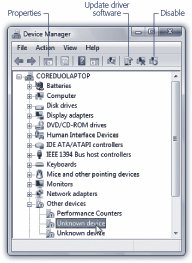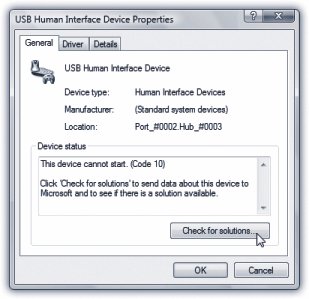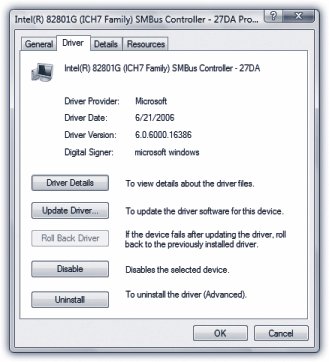Section 18.5. The Device Manager: All Versions
18.5. The Device Manager: All VersionsThe Device Manager is an extremely powerful tool that lets you troubleshoot and update drivers for gear you've already installed. It's a master list of every component that makes up your PC: floppy drive, CD-ROM drive, keyboard, modem, and so on (Figure 18-4). It's also a status screen that lets you know which drivers are working properly, and which ones need some attention.
You can open the Device Manager in any of three ways:
In each of these cases, you're asked to authenticate yourself (page 191). You then arrive at the screen shown in Figure 18-4. 18.5.1. Red Xs and Yellow !s: Resolving ConflictsA yellow exclamation point next to the name indicates a problem with the device's driver. It could mean that either you or Windows installed the wrong driver, or that the device is fighting for resources being used by another component. It could also mean that a driver can't find the equipment it's supposed to control. That's what happens to your Webcam driver, for example, if you've detached the Webcam. A red X next to a component's name usually indicates either that it just isn't working, or that you've deliberately disabled it, as described below. At other times, the X is the result of a serious incompatibility between the component and your computer, or the component and Windows. In that case, a call to the manufacturer's help line is almost certainly in your future. Tip: To find out which company actually created a certain driver, double-click the component's name in the Device Manager. In the resulting Properties dialog box, click the Driver tab, where you'll see the name of the company, the date the driver was created, the version of the driver, and so on. 18.5.1.1. Duplicate devicesIf the Device Manager displays icons for duplicate devices (for example, two modems), remove both of them. (Right-click each, and then choose Uninstall from the shortcut menu.) If you remove only one, Windows will find it again the next time the PC starts up, and you'll have duplicate devices again. If Windows asks if you want to restart your computer after you remove the first icon, click No, and then delete the second one. Windows won't ask again after you remove the second incarnation; you have to restart your computer manually. When the PC starts up again, Windows finds the hardware device and installs it (only once this time). Open the Device Manager and make sure that there's only one of everything. If not, contact the manufacturer's help line. 18.5.1.2. Resolving resource conflictsIf the "red X" problem isn't caused by a duplicate component, double-click the component's name. Here you'll find an explanation of the problem, which is often a conflict in resources (see Figure 18-5).
18.5.2. Turning Components OffIf you click to select the name of a component, the icons at the top of the Device Manager window spring to life. The one on the far right is the Disable button (Figure 18-4), which makes your PC treat the component in question as though it's not even there. You can use this function to test device conflicts. For example, if a red X indicates that there's a resource conflict, you can disable one of the two gadgets, which may clear up a problem with its competitor. When you disable a component, a red X appears next to the component's listing in the Device Manager. To undo your action, click the device's name and click the Enable button in the toolbar (formerly the Disable button). 18.5.3. Updating DriversIf you get your hands on a new, more powerful (or more reliable) driver for a device, you can use the Device Manager to install it. Tip: Newer isn't always better, however; in the world of Windows, the rule "If it ain't broke, don't fix it" contains a grain of truth the size of Texas. In the Device Manager, click the component's name, and then click the Update Driver Software button in the toolbar (identified in Figure 18-4). The Update Device Driver Wizard walks you through the process. Along the way, the wizard offers to search for a better driver, or to display a list of drivers in a certain folder so you can make your own selection. In either case, you may have to restart the PC to put the newly installed driver into service. 18.5.4. Driver RollbackSuppose that you, the increasingly proficient PC user , have indeed downloaded a new driver for some componentyour scanner, sayand successfully installed it using the instructions in the previous paragraphs. Life is sweetuntil you discover that your scanner no longer scans in color . In this situation, you'd probably give quite a bit for the chance to return to the previous driver, which, though older, seemed to work better. That's the beauty of Driver Rollback. To find it, open the Device Manager (page 567), click the component in question, and then click the Properties button. There, you'll find the Roll Back Driver button (shown in Figure 18-6).
Windows Vista, forgiving as always, instantly undoes the installation of the newer driver, and reinstates the previous driver. |
EAN: 2147483647
Pages: 284

 Control Panel; in Classic view, double-click Device Manager.
Control Panel; in Classic view, double-click Device Manager. 
